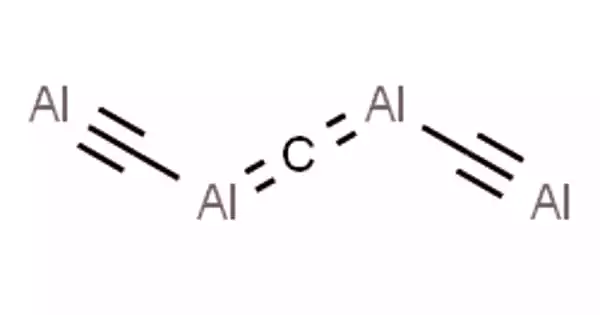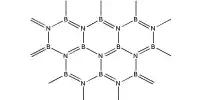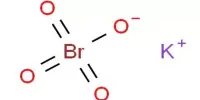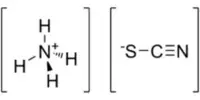Aluminum carbide, chemical formula Al4C3, is an aluminum carbide. It has crystals that range in color from pale yellow to brown. It’s a yellow crystalline substance that combines with water to produce methane. It can withstand temperatures of up to 1400 °C. It decomposes in water and produces methane.
Properties
It has crystals that range in color from pale yellow to brown. It can withstand temperatures of up to 1400 °C. It decomposes in water and produces methane. It features a unique crystal structure composed of two sorts of layers. It is produced in an electric arc furnace through the direct reaction of aluminum and carbon.
- Molecular Weight: 143.96
- Appearance: colorless hexagonal crystals
- Melting Point: 2200° C
- Boiling Point: 1400° C (decomposes)
- Density: 2.36 g/cm3
- Solubility in H2O: Decomposes
- Crystal Phase / Structure: Rhombohedral
Structure
Aluminum carbide has a unique crystal structure composed of alternating layers of Al2C and Al2C2. Each aluminum atom is linked to four carbon atoms to form a tetrahedral structure. Carbon atoms exist in two binding environments: one is a deformed octahedron of 6 Al atoms at a distance of 217 pm, and the other is a deformed octahedron of 6 Al atoms at a distance of 217 pm. The other is a deformed trigonal bipyramidal structure with four Al atoms at 190–194 pm and a fifth at 221 pm. Other carbides have complicated structures as well.
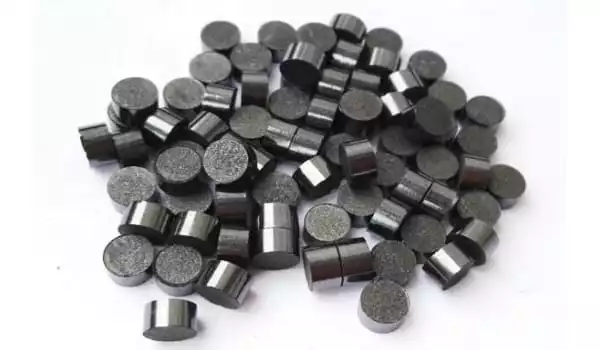
Reactions
Aluminum carbide hydrolyses with the evolution of methane. The reaction proceeds at room temperature but is rapidly accelerated by heating.
Al4C3 + 12 H2O → 4 Al(OH)3 + 3 CH4
Similar reactions occur with other protic reagents:
Al4C3 + 12 HCl → 4 AlCl3 + 3 CH4
Reactive hot isostatic pressing (hipping) at ≈40 MPa of the appropriate mixtures of Ti, Al4C3 graphite, for 15 hours at 1300 °C yields predominantly single-phase samples of Ti2AlC0.5N0.5, 30 hours at 1300 °C yields predominantly single-phase samples of Ti2AlC (Titanium Aluminium Carbide).
Preparation
Aluminum carbide is prepared by direct reaction of aluminum and carbon in an electric arc furnace.
4 Al + 3 C → Al4C3
An alternative reaction begins with alumina, but it is less favorable because of generation of carbon monoxide.
2 Al2O3 + 9 C → Al4C3 + 6 CO
Silicon carbide also reacts with aluminum to yield Al4C3. This conversion limits the mechanical applications of SiC, because Al4C3 is more brittle than SiC.
4 Al + 3 SiC → Al4C3 + 3 Si
The chemical interactions between silicon carbide and molten aluminum in aluminum-matrix composites reinforced with silicon carbide produce a layer of aluminum carbide on the silicon carbide particles, which reduces the material’s strength while increasing the wettability of the SiC particles. This propensity can be reduced by covering the silicon carbide particles with a suitable oxide or nitride, preoxidizing the particles to generate a silica coating, or employing a sacrificial metal layer.
Mechanical alloying can be used to create an aluminum-aluminum carbide composite material by combining aluminum powder and graphite particles.
Occurrence
Aluminum carbide is a prevalent contaminant in technical calcium carbide in small concentrations. Aluminum carbide formed as a corrosion product of the graphite electrodes in the electrolytic production of aluminum.
Aluminum carbide frequently occurs as an undesired product in metal matrix composites based on aluminum matrix reinforced with non-metal carbides (silicon carbide, boron carbide, etc.) or carbon fibers. Carbon fiber reacts with the aluminum matrix at temperatures above 500 °C; improved wetting of the fiber and suppression of chemical reaction can be obtained by coating it with, for example, titanium boride.
Applications
Aluminum carbide particles finely dispersed in an aluminum matrix reduce creep, especially when combined with silicon carbide particles. It is an abrasive that can be utilized in high-speed cutting instruments. It is almost the same hardness as topaz.
